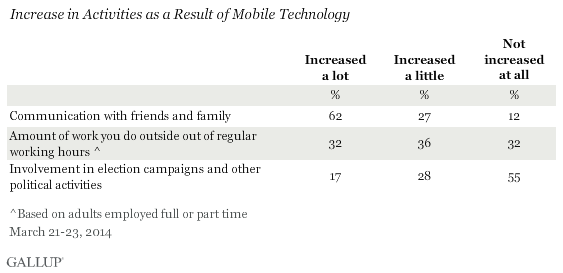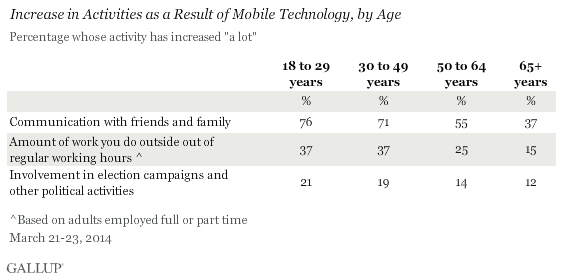This article is part of a weeklong series analyzing how mobile technology is affecting politics, business, and well-being.
PRINCETON, NJ -- Mobile technology, including the use of smartphones and tablet computers, has affected many aspects of Americans' lives, but most notably their communication with friends and family. Sixty-two percent of Americans say mobile technology has increased their interpersonal communication "a lot," with another 27% saying it has increased it "a little." Two-thirds of U.S. workers say they are now working at least a little more outside of working hours as a result of mobile technology. Slightly less than half of Americans say mobile technology has increased their political activity.

The results are from a March 21-23 Gallup poll designed to assess how much mobile technology has affected Americans' behavior in the personal, political, and work areas.
The poll finds that seven in 10 Americans use either a smartphone or a tablet, devices that didn't exist 20 years ago, making the high level of reported use of a mobile device one of the most dramatic shifts in generations in the way Americans communicate and access information. These mobile devices have many implications for Americans' daily personal and work lives, allowing them to stay in touch with others outside of the home and office, and changing the way they approach their jobs.
Because mobile technology usage is higher among younger Americans, it is not surprising that younger adults are more likely than older Americans to report that mobile technology is having a greater effect across their personal, work, and political lives. But it is not just the under-30 crowd whose lives are being most affected. Those between the ages of 30 and 49 are just as likely as 18- to 29-year-olds to report that their interpersonal communication, work outside of working hours, and political involvement have increased a lot with the rise of mobile technology.
Those older than 50, particularly those 65 or older, are less likely to have been affected to a large degree by mobile technology.

Implications
Mobile technology has certainly increased Americans' opportunities to stay in touch and perform tasks that at one time could be accomplished only by sitting at a computer or using a landline phone. More than anything, it has increased nearly all Americans' communication with friends and family at least a little bit. Although it has had a less profound effect on the frequency with which Americans participate in the political process and work outside of regular working hours, it still has substantially affected their behavior in these areas.
Given the greater likelihood of younger Americans than older Americans to say mobile technology has increased their activity in the interpersonal, work, and political spheres, it is likely mobile technology will foster even greater activity in these areas in the future.
The increased ability to communicate with friends and family that mobile technology affords is presumably a positive, although some may complain of "communication overload" with the constant text messages, social media posts, and emailing that cause one's mobile device to beep, vibrate, or make noise throughout the day.
Whether the ability to do more work away from an employee's place of business is a positive or a negative is an intriguing question that will be answered in greater depth in a forthcoming analysis on gallup.com. Americans are less likely to report that their political activity has increased as a result of mobile technology compared with the other areas tested, but, as Gallup will explore in a future report, the ability to reach potential voters and campaign contributors on a 24-hour basis has the potential to change how candidates and elected officials go about their business.
Read a related article at Gallup Business Journal.
Survey Methods
Results for this Gallup poll are based on telephone interviews conducted March 21-23, 2014, on the Gallup Daily tracking survey, with a random sample of 1,505 adults, aged 18 and older, living in all 50 U.S. states and the District of Columbia.
For results based on the total sample of national adults, the margin of sampling error is ±3 percentage points at the 95% confidence level.
For results based on the total sample of 855 adults employed full or part time, the margin of sampling error is ±4 percentage points at the 95% confidence level.
Interviews are conducted with respondents on landline telephones and cellular phones, with interviews conducted in Spanish for respondents who are primarily Spanish-speaking. Each sample of national adults includes a minimum quota of 50% cellphone respondents and 50% landline respondents, with additional minimum quotas by time zone within region. Landline and cellular telephone numbers are selected using random-digit-dial methods. Landline respondents are chosen at random within each household on the basis of which member had the most recent birthday.
Samples are weighted to correct for unequal selection probability, nonresponse, and double coverage of landline and cell users in the two sampling frames. They are also weighted to match the national demographics of gender, age, race, Hispanic ethnicity, education, region, population density, and phone status (cellphone only/landline only/both, and cellphone mostly). Demographic weighting targets are based on the most recent Current Population Survey figures for the aged 18 and older U.S. population. Phone status targets are based on the most recent National Health Interview Survey. Population density targets are based on the most recent U.S. census. All reported margins of sampling error include the computed design effects for weighting.
In addition to sampling error, question wording and practical difficulties in conducting surveys can introduce error or bias into the findings of public opinion polls.
View survey methodology, complete question responses, and trends.
For more details on Gallup's polling methodology, visit www.gallup.com.
